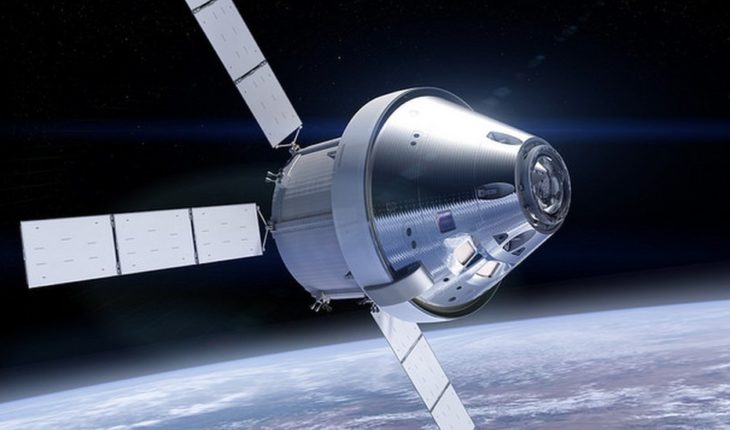a new space era is about to begin.
Or, at least, that create NASA.
More than four decades after the last moon landing, the National Aeronautics Administration and the United States (NASA) space prepares to send a man to the moon… and beyond.
Orion, a ship designed in collaboration with the European Space Agency, will be the vehicle for the trip “legendary” which aims to follow the course of the cosmos to Mars and other remote corners of the “deep space”.
And, after several years of testing, capsule received Friday the last boost he needed to be operational: a module designed by Airbus that will endow it with electrical, propulsion, thermal control, air and water.
It is the first time that NASA uses a device built in Europe as a critical element to boost a U.S. spaceship that, according to experts, gives account of “international cooperation in space matters”, but also of the magnitude of the project.
NASALa NASA received Friday the module created by the European Space Agency.
According to the U.S. Space Agency, although initially Orion will carry out an unmanned, mission, in addition to carry cosmonauts into space, aims to build an outpost beyond of the Moon that could allow expeditions to Mars.
Although there is still no exact dates for the first manned expedition, is believed to take place at the beginning of the Decade of 2020.
In the opinion of the head of the European Space Agency, Jan Wörner, this will be a “whole new way” to travel to space and a “new-type” return to the moon.
In case realized the expedition, Orion is the ship designed to transport crew members arriving further since man came into space more than half a century ago.
Orion, the Hunter’s space design, production and testing of the ship with which NASA intends to launch this new space age have run a long and bumpy road.
The original idea came up in 2011 as part of the constellation project, an idea of the George W. Bush Administration to bring back a man to the Moon and which was suspended due to lack of budget the Government of Barack Obama arrived.
However, NASA continued the development of the capsule.
Although the initial project aimed at Orion to carry six people in their missions, the number was finally reduced to four, and gave the construction of one of its two main modules to ESA (which was received Friday at Cape Canaveral).
NASALa ship consists of two modules, one of them manufactured in Europa.segun description of NASA, the design of the capsule of five meters in diameter and 21 tons of weight takes basic elements of the Apollo command module, famous ships of the missions that They carried astronauts to the Moon between 1969 and 1972.
However, the space agency ensures that the technology and capacity of Orion will allow to perform more advanced and longer space missions.
It is estimated that, with crew aboard, you can travel without the need for new provisions up to 21 days, while in idle state you can maintain conditions of usefulness for another 6 months.
During this last period, according to NASA, is expected that the crew life support would be provided by other space modules.
New design this week, NASA tested also one of the most revolutionary features that will ship: a module’s descent that combines parachute and retro-rockets, or airbags, for the recovery of the capsule when it returns to the Earth.
NASAEl Lander combined parachute and retro-rockets for the recovery of the capsule when return to the Tierra.De agreement with the Agency this mechanism, similar to that used by the Russian Soyuz or the Chinese Shenzhou capsules, you will eliminate the costs of having that use a fleet of boats as it did before in Project Mercury, Gemini and Apollo flights.
Another of its characteristics is that it is designed for partial re-use of the module’s crew, which may be used by 10 flights, which will lower costs and will also build a fleet of these devices.
So the ship can also serve to the space station, its design allows you to attach to other vehicles automatically, although as safety pilot can take command and perform the manoeuvre in case of emergencies.
A new era in space since 1972, when was the last moon landing, until recently, trips to the Moon or more beyond lost interest.
But in recent years time are more State and private initiatives that not only announce a return to the satellite, but ambitious plans of colonization, most of them based on the lowering of the technologies and the manufacture of spacecraft.
China, for example, plans to land in 2018, while Russia announced that it will put a ship there to 2031.
Meanwhile, many private initiatives currently seek a business model space, ranging from exploiting minerals that exist in the moon to sell pieces of the satellite as a gemstone.
And, apparently, United States does not want to be outdone.
The U.S. Space Agency says for years there are still great reasons to return to the moon.
NASA believes that a man there turn could bring a greater understanding of lunar science and enable the implementation of new technologies in the field.
Now you can receive notifications of BBC world. Download the new version of our app and activate them so you don’t miss our best content.
translated from Spanish: Orion, the ship that NASA points to the Moon and Mars
November 19, 2018 |





